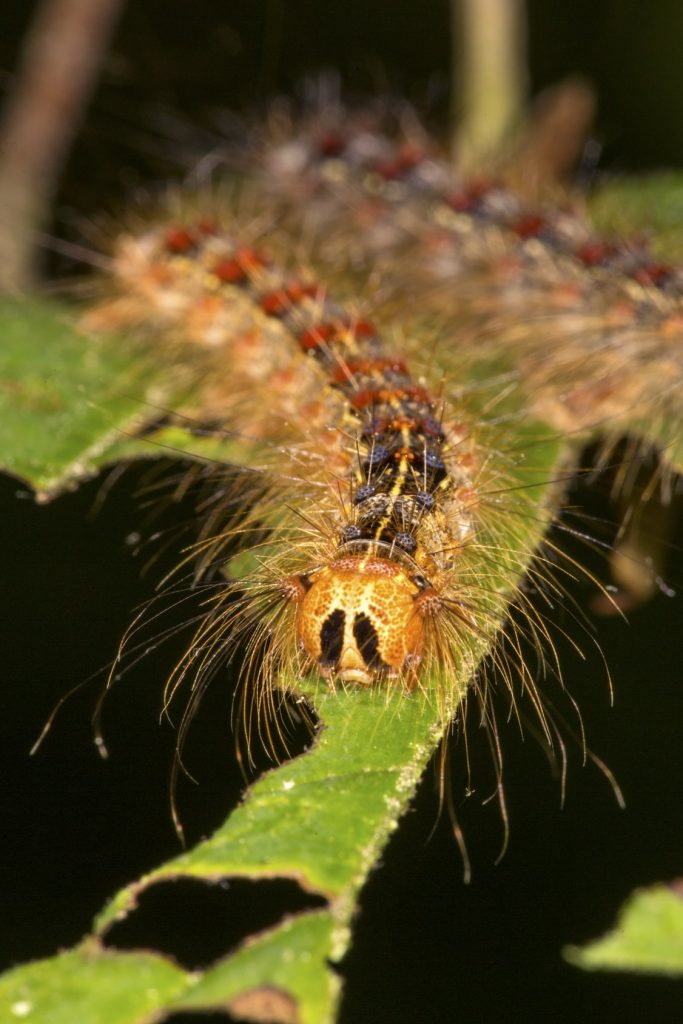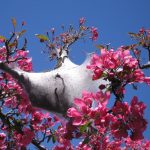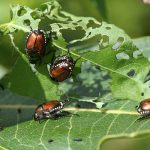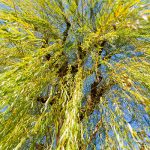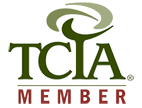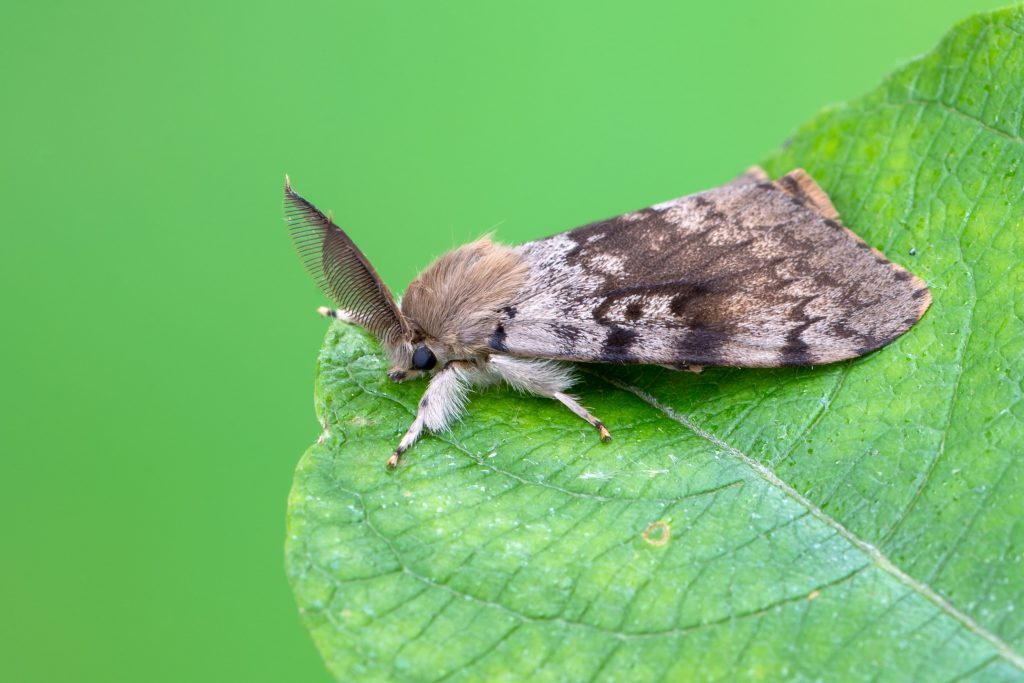
The adult gypsy moth does not eat your tree foliage, but lays eggs that will hatch the following season that will harm the tree
We return this week with our series on the common tree diseases and insect pests in the Chicago area with a closer look at a pest responsible for widespread defoliation, the gypsy moth. The gypsy moth (Lymantria dispar dispar), also known as the European gypsy moth, is an invasive species from Europe. It is known to devour the foliage of hundreds of species of trees and shrubs and can destroy millions of acres of trees in a single season. Trees attacked by the gypsy moths are not usually killed unless they are already weakened, but multiple seasons of defoliation of a single tree caused by the gypsy moth can make it more vulnerable to diseases and other insect infestations that can lead to the death of the tree.
Gypsy moths were introduced to the U.S. in 1869 by Etienne Leopold Trouvelot who wanted to start a silkworm industry by interbreeding the gypsy moths with silkworms. It is believed that the gypsy moths escaped his residence in Massachusetts, and it is unknown how Trouvelot reacted or if he alerted officials of the release. It wasn’t long before they became a notable nuisance as the first destructive outbreak occurred in 1889. After this outbreak, entomologist Maria Elizabeth Fernald discovered that the gypsy moth caterpillar was responsible and the next year they began an eradication program to eliminate the moth. However, the gypsy moth continued to spread as the larvae can be carried by the wind and its eggs can be transported in firewood. It has spread to cover all of the New England area and has made it as far west as Wisconsin and Illinois.
Gypsy moth caterpillars have dark bodies with lighter colored faces, red and blue spots on their backs, and hairs that protrude from their bodies. They are pests in their larval stage as adult gypsy moths only live for about a week and they do not feed because they have no digestive systems. It is important to look for signs of gypsy moth egg masses and caterpillars early in the season to prevent defoliation of your trees.
Fortunately, there are ways to control gypsy moths to help prevent defoliation. If you believe the trees on your property may be affected, talk to our professional arborists at Hendricksen Tree Care. We provide tree treatment and maintenance services to help protect your trees from infestations and take action if your trees are affected by the gypsy moth. Our arborists will assess the infestation of your trees and come up with a solution that will rid your trees of these pests.
Life Cycle of the Gypsy Moth
 A gypsy moth egg sac growing on an oak tree
A gypsy moth egg sac growing on an oak tree
Gypsy moths have one life cycle per year that consists of four stages: eggs, larval, pupal, and adult.
- Eggs: Adult gypsy moths mate and lay eggs in the late summer and the eggs overwinter until they hatch the following spring. The eggs are usually laid on branches and tree trunks and they appear as whitish yellow fuzzy masses. These hairy eggs masses are about an inch to an inch and a half long and may contain 400 to 500 eggs. After the eggs are laid the female covers them with hairs from its own body which provide protection and insulation from predators and the cold winter weather. The eggs can overwinter for 8 to 9 months before the larvae emerge in late spring by chewing through the egg and the protective layer.
- Larval stage: When the larvae first emerge, they will disperse from the egg masses to find foliage to feed on. The wind helps to disperse the larvae as they hang from the leaves by silk threads. They feed during the day at first but become nocturnal feeders as they grow. When they are done feeding, they will hide on the underside of leaves or within crevices in the bark. The larvae have slender black bodies with tan colored faces, and their bodies are lined with pairs of blue spots near their heads and pairs of red spots on the tail end of their bodies along with hairs called setae. They molt as they grow and may reach up to 9 cm in length. They generally enter their pupal stage by late June.
- Pupal stage: Gypsy moths enter the pupal stage starting in June and this stage lasts for 14 to 17 days before they emerge as adult moths. They generally pupate where they rest as larvae, within crevices, under bark, and on the ground, but they may pupate in more open locations such as exposed on tree trunks and branches in areas with dense gypsy moth populations.
- Adults: Adult gypsy moths emerge from the pupal stage in July, with male moths emerging a day or two before the female moths. Male moths are brown in color with feathery antennae and are about 30 to 35 mm in length. Female moths are white in color and tend to be 20 to 24 mm in length but unlike male moths, females do not fly. When the females emerge, they release a pheromone that attracts males for mating. After mating, the female lays the eggs and covers them with hairs to form the protective egg mass. Adult moths only live for about a week and they lack a digestive system, so they do not feed during their adult period.
Gypsy Moth Feeding in Illinois
Gypsy moths cause damage to trees in their larval stage when they are feeding on leaves. These moths are not picky eaters as they are known to eat the leaves of 500 different species of trees and shrubs, including trees that are commonly found in the Chicago area such as oak trees, beech trees, birch trees, maple trees, pine trees, spruces, alders, cherry trees, linden trees, dogwoods, cedars, sycamores, and much more.
Gypsy moth caterpillars can cause significant defoliation as just one caterpillar can eat up to 11 square feet of vegetation. This means that a large population of gypsy moth caterpillars can completely defoliate large sections of forested areas. Trees and shrubs attacked by gypsy moth caterpillars are likely to survive and may even start re-growing leaves by the end of the season. However, repeated attacks make trees weaker and more vulnerable to diseases and other pests that can cause the death of the tree. Trees that are already weakened can be killed in a single attack.
Signs of a Gypsy Moth Infestation
It is important to look for signs of a gypsy moth infestation early in the spring before they hatch and start feeding on your trees. The following are signs of the presence of gypsy moths:
- Egg masses: As described above, the tear-shaped, whitish yellow egg masses can be found on tree branches and tree trunks, under rocks, and even on outdoor furniture. Look for these hairy masses early in the season but be careful not to touch them directly because they can cause a rash.
- Half eaten leaves: If you notice that the leaves on your trees look half eaten by mid spring, start looking for gypsy moth caterpillars in the trees. They can be found in crevices in the bark and attached to the underside of leaves by their silk.
- Adult moths: As described above, adult male gypsy moths are brown with feathery antennae and female moths are white and flightless. If you see adult gypsy moths in mid-summer, look for their egg masses once the fall arrives.
Gypsy Moth Control
Because the gypsy moths cause the most damage in their larval stage, it is best to take action to control them before their eggs hatch. However, there are methods of gypsy moth control that are effective at each stage of their life cycle.
- Destroy egg masses: Destroying the egg masses early in the season can prevent damage to your trees. You can destroy the egg masses by crushing them or by burning them with kerosene. Putting the eggs in a bucket of soapy water will also kill them. Be careful not to touch the egg masses directly to avoid allergic reactions and do not simply remove them from the tree and throw them on the ground. If there are a lot of eggs on your property, it may be best to call a professional arborist to take care of the problem.
- Wrap your trees: Tree wraps like burlap provide hiding places for gypsy moth caterpillars, making it easy to get them in a central location. You can simply crush the caterpillars under the tree wrap if their population is small enough.
- Barrier bands: Barrier bands, including various types of tape and grease can help prevent the larvae from crawling up tree trunks to the foliage. Make sure you apply barrier bands correctly and don’t let them touch the tree directly.
- Insecticide: Various insecticides can be used to eliminate gypsy moth caterpillars and their eggs if there is a large population. Make sure you call a professional arborist like Hendricksen Tree Care to administer insecticide treatments.
- Care for your trees: While gypsy moths can attack healthy trees, they prefer trees that are already stressed. Taking care of your trees will prevent them from getting stressed and make them a less likely target. Make sure your trees are properly watered, fertilized, and pruned to promote their health. Our professional arborists can assist with basic tree care including tree trimming.
Gypsy Moth Treatment and Control Options from Hendricksen Tree Care
Since becoming an invasive species in the U.S., gypsy moths have spread from New England to the Midwest and caused widespread defoliation. While they alone will not usually kill a tree, defoliation can stress a tree and make it vulnerable to diseases and other pests that can cause its death. Trees that are attacked by gypsy moths multiple years in a row are at a higher risk for more serious problems. It is best to have the moths removed from your trees to prevent significant defoliation.
Our arborists at Hendricksen Tree Care can identify the signs of a gypsy moth infestation and take the appropriate steps to eliminate them from your property. We can effectively administer insecticide treatments to kill the eggs and we can also help ensure that your trees are properly fertilized and pruned to make them less of a target. We are available to provide tree services in Northbrook, Arlington Heights, Winnetka, Palatine, Park Ridge, Mount Prospect, Highland Park, and the surrounding areas of the north and northwest Chicago suburbs.
Watch out for our next edition of our series on the common tree diseases and pests in the Chicago area.
